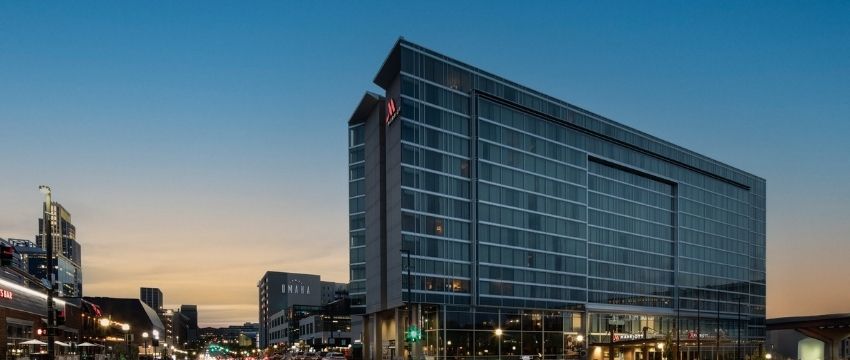In the vibrant heart of Nebraska’s largest city, Omaha, lies the downtown Omaha Marriott, serving as a notable urban hospitality benchmark for the region. Since its opening, this property has become a hallmark in the rejuvenated downtown scene of Omaha.
The accommodation combines upscale rooms with a prime location in the entertainment district, making it appealing to both leisure and business travelers. It anchors the Capitol District, a centerpiece of the development transforming downtown Omaha into a bustling hub of activity.
Its location places guests close to major venues and attractions, many within walking distance. The modern architectural design adds to Omaha’s skyline and reinforces the hotel’s distinctive presence.
The Omaha Marriott Downtown is part of a broader urban renewal effort aimed at revitalizing the city’s downtown core. This reflects a national trend in which prime hotel properties anchor entertainment districts, contributing to the overall growth of urban hospitality markets.
The Capitol District represents a significant investment in infrastructure for tourism and conventions in Omaha. Establishing a flagship property here underscores Marriott International’s strategy to expand into mid-sized cities where business and leisure travel routes are evolving.
Omaha has increasingly appeared as a destination on the hospitality map, hosting events like the NCAA Men’s College World Series and serving as a regional business hub for the Midwest. The hotel was built as part of a $205 million mixed-use development that transformed the downtown landscape.
Similar urban core redevelopment projects in cities such as Kansas City, Indianapolis, and Des Moines also feature luxury hotels anchoring entertainment districts, reinforcing the model’s success in revitalizing central business areas.
Prime Location and Accessibility
One of the hotel’s strongest advantages is its location in the Capitol District, steps from CHI Health Center Omaha, the city’s premier convention and arena complex.
It is a preferred accommodation for major concerts, sports events, and conventions. Charles Schwab Field, less than half a mile away, draws large crowds during the College World Series each June.
The Orpheum Theater is within walking distance, hosting Broadway touring productions and other performing arts. A free round-trip shuttle service between the airport and hotel makes travel convenient for guests, particularly business travelers on tight schedules.
Culinary Offerings

The hotel’s dining options reflect a commitment to quality and variety. Society 1854, its signature restaurant, offers refined American cuisine with a focus on Nebraska’s agricultural heritage.
The restaurant’s name references Omaha’s founding year, adding a historical touch. Burdoch and Bitters provides a more casual setting, specializing in craft cocktails and shareable plates that appeal to both guests and local patrons.
Comprehensive Amenities Package
Amenities cater to both leisure and business travelers. In summer, the outdoor pool offers a resort-like setting with loungers and umbrellas, creating a relaxing retreat in the city.
The fitness center features modern cardio and strength equipment. Guests can also take advantage of complimentary bicycles to explore downtown Omaha, promoting eco-friendly transportation and a more immersive city experience.
Business and Event Capabilities
The Omaha Marriott Downtown at the Capitol District is a leading venue for corporate and social events. Six event spaces accommodate everything from board meetings to large conferences and wedding receptions.
With over 17,000 square feet (about 1,600 square meters) of space, the hotel offers state-of-the-art audiovisual equipment and technical support to ensure events run smoothly.
The catering service provides customizable menus for different dietary needs, supporting events from business luncheons to formal banquets. The hotel’s service level makes it a strong competitor in Omaha’s event market.
Expert Analysis
Industry analysts consider the Omaha Marriott Downtown a prime example of successful urban hotel development. High occupancy rates, often above market averages, validate its strategic location and service quality.
Tourism experts note that the hotel has elevated Omaha’s profile, enabling it to compete more effectively for regional and national events. This benefits the city’s broader hospitality and tourism sectors.
The property’s role in the Capitol District project is often cited as a model for mixed-use developments, demonstrating how hospitality, dining, residential, and entertainment elements can work together to boost economic impact.
Recent upgrades and service training reflect Marriott’s focus on maintaining a competitive edge as the downtown area continues to grow. The location’s appeal will likely increase alongside Omaha’s broader development.
Travel trends suggest that walkable areas with authentic local character are becoming more attractive to travelers. The hotel’s connection to the community, combined with steady corporate business, provides stability even when leisure travel patterns shift.
As Omaha strengthens its position as a regional hub for sports, entertainment, and business, the Marriott Downtown is well placed to benefit from rising visitor numbers. Its reputation for exceeding guest expectations positions it for continued success in the competitive hotel market.










